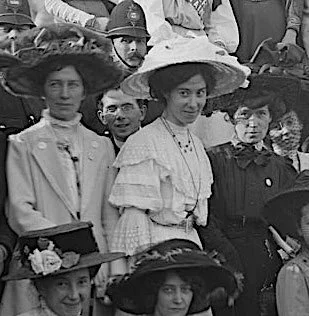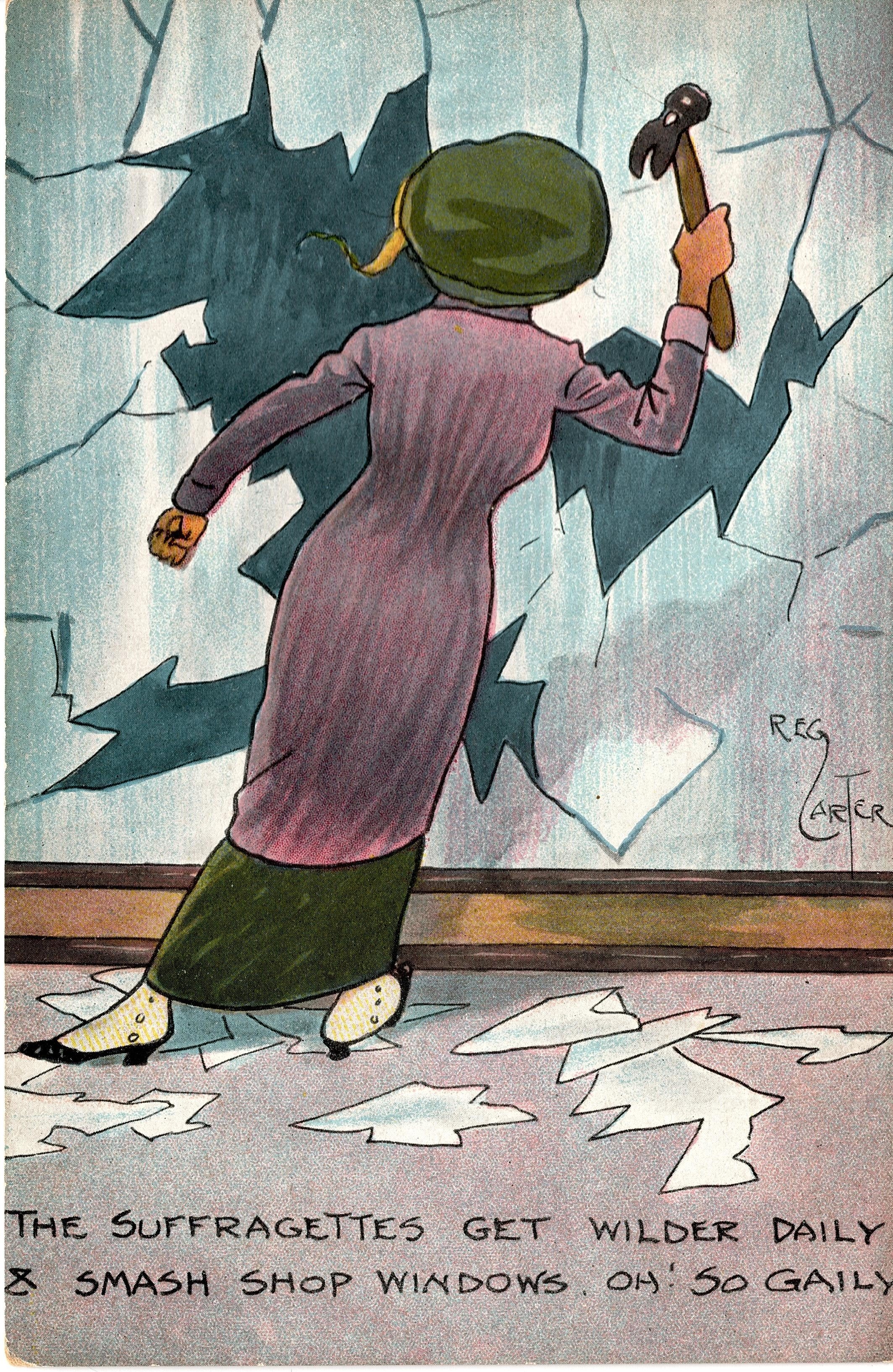London vs Suffragettes
Between 1907 and 1914, the Suffragettes - members of the Women’s Social and Political Union, led by Emmeline Pankhurst - transformed the capital into a theatre of protest and conflict. Their carefully choreographed, increasingly dramatic performances profoundly altered life in London. By Jane Hayward
-

Hyde Park high point
Emmeline Pankhurst was determined that Londoners should see Suffragettes as stylish, respectable women united in the fight for suffrage. To achieve this, the WSPU organised ever-more spectacular events, culminating in Women’s Sunday at Hyde Park on 21 June 1908. An astonishing 500,000 women poured off chartered steam trains, most wearing the purple, green and white sashes of the new ‘suffragette uniform’, and marched under 700 embroidered banners in what became the UK’s largest protest. The Lakes Herald reported on the diverse crowd that arrived at the park, including “teachers, mill and factory workers, shop assistants, clerks, journalists, novelists, musicians, a playwright, a bachelor-of-law, a tailoress and a nurse”. Mrs Pankhurst topped a bill of 100 speakers, and the event concluded with a cheer like “the roar of a football crowd’.
Photo: Christina Broom, LSE Library
-

Police violence at Westminster
On 18 November 1910, a march on Parliament staged by 300 Suffragettes went disastrously awry. The WSPU were protesting the Government’s abandonment of a Bill that would have granted limited female suffrage. Expecting the usual arrests, they were instead met with six hours of relentless police violence including physical and sexual assaults, in which male bystanders were allowed to participate. Rosa Billinghurst, a wheelchair user, was deliberately thrown to the ground. Black Friday, as it became known, caused a decisive change the SWPU’s campaign. Unwilling to risk further attacks on demonstrators, they switched to more militant, often clandestine action.
Image: public domain via Wikimedia Commons
-

Oxford Street pays the price
On 1 March 1912, the sound of shattering windows rang around Oxford Street, Regent Street and Knightsbridge. The WSPU’s new tactics were launched with a coordinated attack on London’s smartest stores. An article written for The National Archives reveals that around 150 Suffragettes, armed with hammers, bricks and clubs, had answered a call to arms from Mrs Pankhurst. “I am with you in heart and soul… a soldier to the death,” answered one, Ellen Pitfield, a nurse from Euston. Calling cards were left in the form of suffragette colours or angry notes demanding the vote. This was a type of campaign never seen in London before, and resulted in heavy prison sentences (76 women, many from working-class families, were put to hard labour), lending strength to the WSPU’s argument that the Government cared more about property than they did about women’s lives.
Illustration: Reg Carter, public domain via Wikimedia Commons
-

Holloway calling
An unforeseen consequence of the window-smashing campaign was that Emmeline and Frederick Pethick-Lawrence, the WSPU’s main funders, were found guilty of conspiracy - despite opposing the tactics - and each sentenced to nine months in prison. Emmeline joined the increasing ranks of Suffragettes in Holloway Prison. It became the subject of cartoons and music hall sketches - “I say, my wife’s in Holloway for six months.” “On holiday for six months? Whatever for?” “No, Holloway. For smashing windows” who went on hunger-strike in protests at not being given political prisoner status and were force-fed, a brutal process that alarmed the public and brought the Suffragettes much sympathy. However, she and Frederick refused to support further violent activism, and the couple were expelled from the WSPU.
-

Postboxes go up in smoke
This postbox in Highbury was discovered in flames in January 1913, one of dozens set on fire by Suffragettes between 1912 and 1914. Christabel Pankhurst masterminded the arson campaign while Emily Davison was the most prolific offender, and was given six months in Holloway after she was caught with a kerosene-soaked rag and a lit match in Parliament St. As postboxes carried a royal cipher, they were a symbolic target. But the damage to people’s every day lives, while effective in gaining attention, made it an unpopular tactic. Judges suggested they might prevent news of a dying relative or an important job getting through. Emily was unrepentant, however, declaring it “the next step to window breaking”.
Photo: A Trip Up My Sleeve
-

Arson and old lace
Titled The Fifth of November, the Punch cartoon shows two women. “Coming to our bonfire,” asks one. “Ra-ther,” replies the other. “Whose house are you burning?”
By 1913, the idea was destroy ‘peace, property and sport’ until women got the vote. mansions, golf courses, churches and football stadiums were burning down - Woolwich Arsenal FC lost theirs and moved to North London, where they became simply Arsenal FC. “We just want you to get riled up,” Mrs Pankhurst told male sports enthusiasts. The attacks were carried out by a group of young single women named the Young Hot Bloods by the WSPU. Suffragettes didn’t spare gardeners either. After destroying several of Kew’s rare orchids, xx burned down the teahouse.
-

Mass demos like Women's Sundays
Women were encouraged to boycott the 1911 census by refusing to be counted in their homes, or by spoiling their forms with a Votes for Women slogan. Mary Howey, from Bradley in Hertfordshire, wrote this on her census and listed her occupation as ‘artist and suffragette’ and under ‘infirmity’ wrote ‘not franchised”. Her company director husband wrote a note on the form describing her as “a silly suffragette”. Some made a bigger gesture. I think it was Emily Davidson who hid in the House of Commons?
-

Rushes on Parliament
england’s first university professor, Edith Morley who taught at University College, Reading, refused to pay her taxes in protest of women’s disenfranchisement. As a consequence her belongings were seized and sold. She suffered discrimination for her views, being banned from Reading train station?
-

Art slashed
On St Paul’s, the Bank of England and Westminster Abbey
-

Arsenal destroyed and golf clubs
Women were encouraged to boycott the 1911 census by refusing to be counted in their homes, or by spoiling their forms with a Votes for Women slogan. Mary Howey, from Bradley in Hertfordshire, wrote this on her census and listed her occupation as ‘artist and suffragette’ and under ‘infirmity’ wrote ‘not franchised”. Her company director husband wrote a note on the form describing her as “a silly suffragette”. Some made a bigger gesture. I think it was Emily Davidson who hid in the House of Commons?
-

Disrupting public events
england’s first university professor, Edith Morley who taught at University College, Reading, refused to pay her taxes in protest of women’s disenfranchisement. As a consequence her belongings were seized and sold. She suffered discrimination for her views, being banned from Reading train station?
-

The Derby
On St Paul’s, the Bank of England and Westminster Abbey